What are electric bikes (group review in two parts of five models of two manufacturers), part 1
The most popular types of personal electric vehicles now are electric scooters and electric bicycles.
The advantage of electric scooters is compactness, but they have one very severe limitation: according to the rules of the road (SDA), they are equated with pedestrians and have the right to ride only on sidewalks.
In this regard, they are very good for leisurely trips over short distances; and over long distances they are significantly inferior to electric bicycles, which move faster due to the ability to move on highways (except for those where it is forbidden).
This article (in two parts) will briefly describe and present the test results of five models of electric bikes from two manufacturers. Of course, they do not cover all the variety of existing models of electric bicycles, but the most “typical cases" are well represented. This will help orient the future owner of the electric bike in possible options and realize which bike is suitable for him.
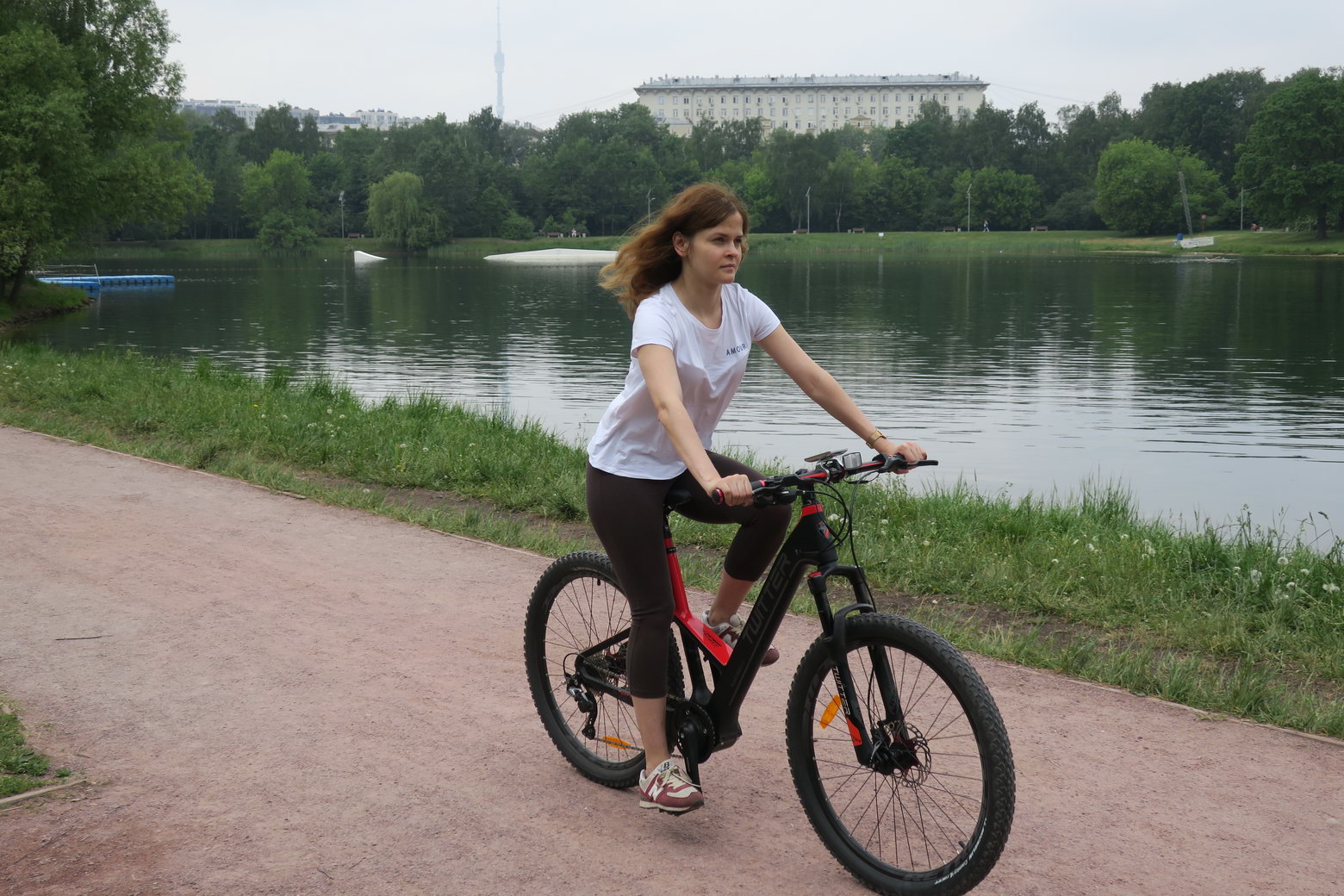
Among the monitored are two models in which the electric motor serves as a means of help and turns on only if the cyclist turns the pedals; and three models in which the motor can work completely autonomously. Conventionally, we call the first group “for the lazy”, and the second group - “for the lazy”.
Let's start with the first group (this will be the first part of the review). Two models will be considered here:Twitter Mantis-E1 and Twitter TW-E9L .
The model is made in Shenzhen, the center of the Chinese electronic industry, and has nothing to do with the social network Twitter.
You can even say that they called their products in vain: according to Twitter, finding a social network on the Internet is much easier than a bicycle manufacturer. But this does not affect the driving performance of the bike.
The model is a powerful (350 W) electric bike with a “classic” design, including a motor wheel and a battery pack.
The word “powerful” was not used accidentally: according to the SDA, this model is no longer an electric bike, but an electric pedologist; since electric bicycles are considered devices with a power of only up to 250 watts. But externally, the model is no different from bicycles, so in the review it will still be called an electric bike.
Let's look at it in a general view (right and left):

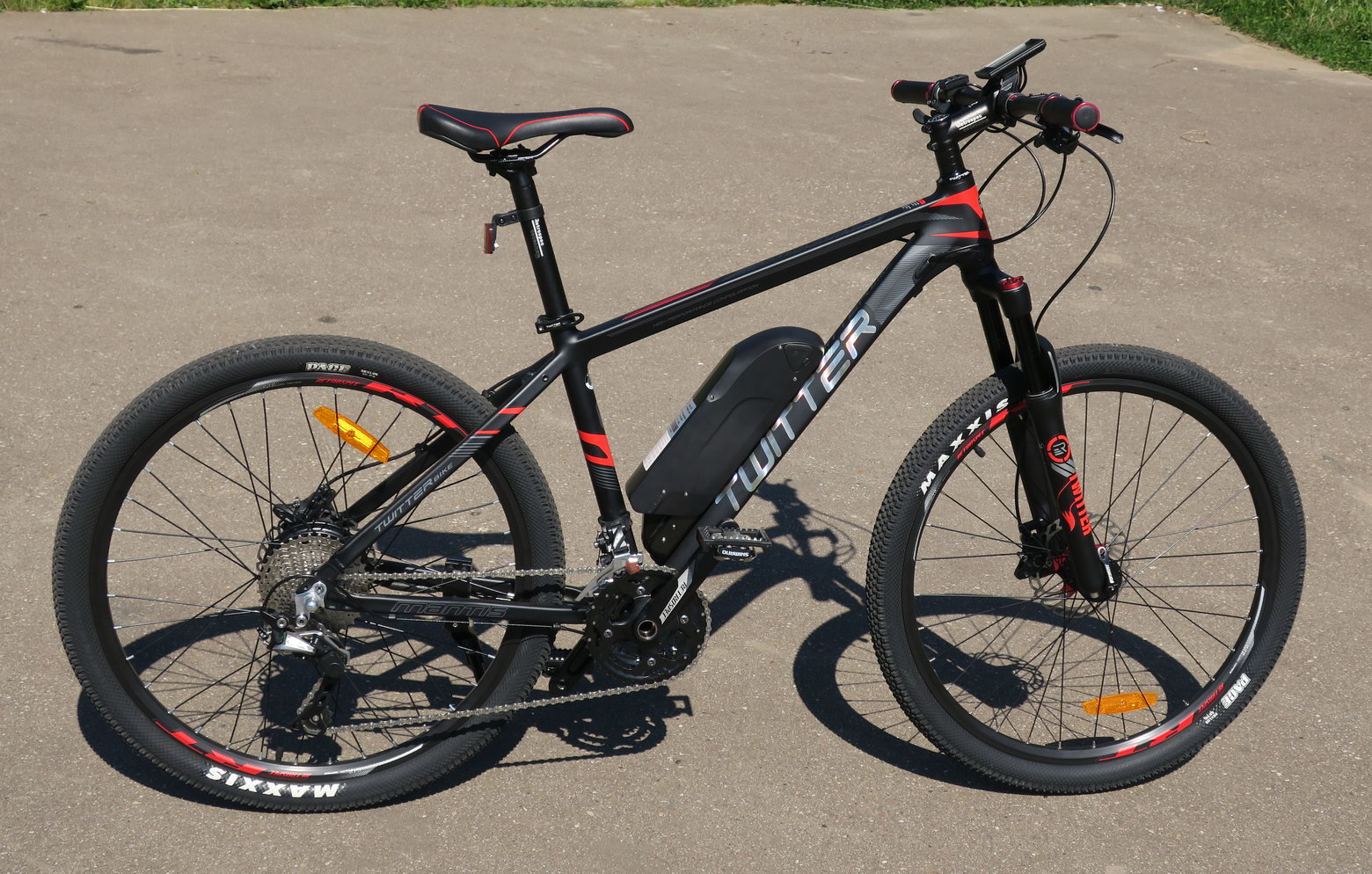
Before further narration, we will familiarize ourselves with the main technical parameters of an electric bike :
Wheels - 26 ", double pistoned rim.
Mass of the bike - 17.9 kg
Frame - aluminum, 15.5" / 17 "
Plug - aluminum-magnesium alloy , damper with step adjustment of compression (6 levels + "closed")
Gear shifters- Shimano SLX, 33 speeds, (11 * 3)
Brakes - hydraulic disc, Shimano SLX
Tires - MAXXIS-PACE, 26 "× 1.95"
Use modes - help mode and pedal mode (there is no driving mode only by motor power)
Electric drive parameters:
Quantity help mode levels - 5
Battery - removable, 36 Volt, 13 Amp-hours
Motor - rear motor-wheel, brushless, 350 W
Maximum speed - 35 km / h
Mileage on a single charge - up to 120 km (in help mode)
Dashboard - LCD display
All the parameters are available on the bike’s specifications page .
The price of a bicycle is 119990 rubles, but some sellers sell 5 thousand more.
Let's look at the center of the bike with the saddle:

First, look at the crosshairs of the frame parts under the saddle. Pay attention to their smooth connection.
The manufacturer calls this connection “seamless welding”. In fact, welding is the most common there, but the seams are smoothed and polished, which gives the electric bike a beautiful, modern look.
The saddle is moderately stiff, close to sports. Some owners will need some getting used to, but no replacement is required.
The battery pack has a lid, behind which there are connectors and a switch:
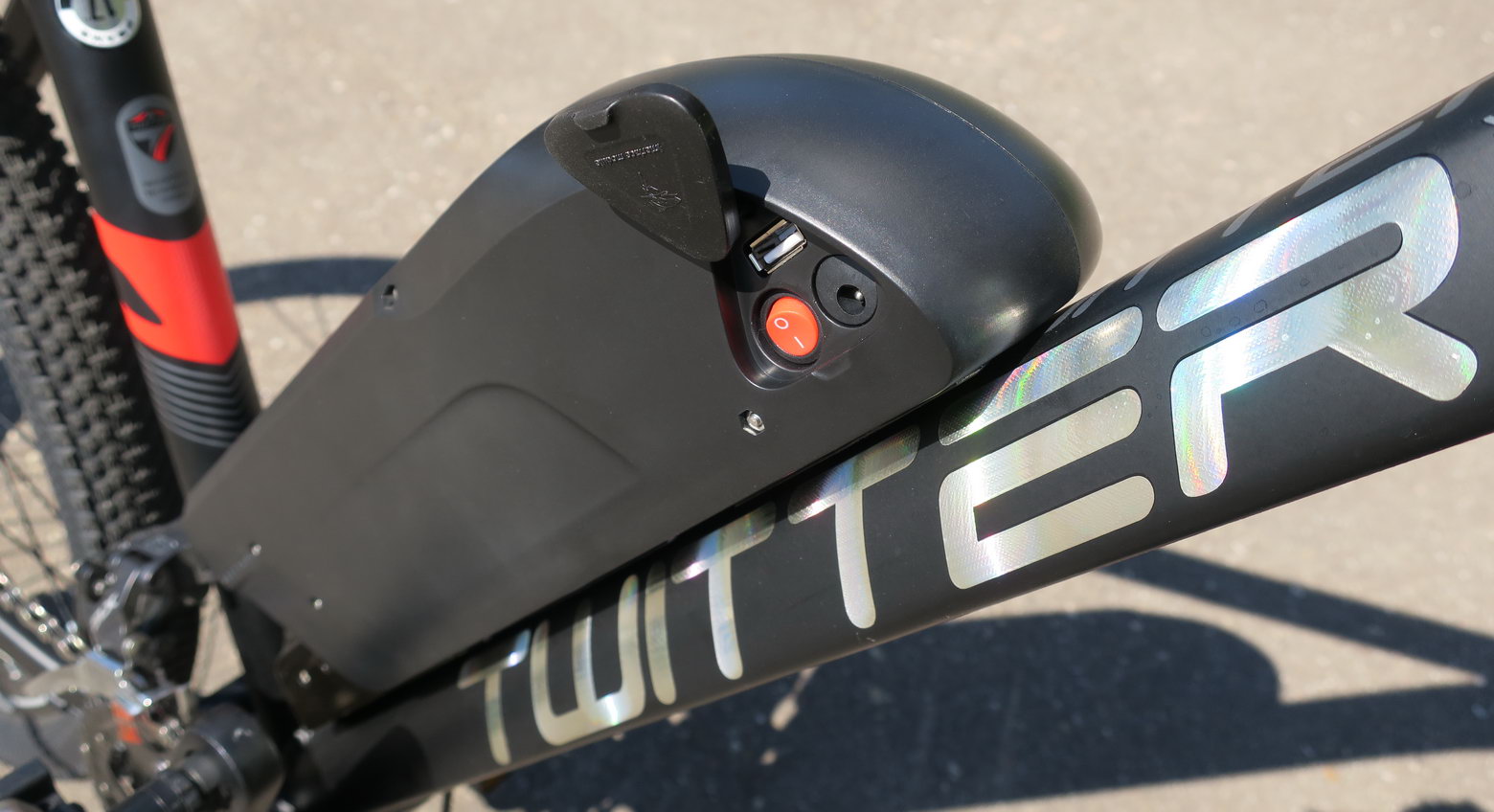
The USB connector is designed to recharge mobile devices from this unit on halts; and a round connector - for charging the battery pack itself.
Due to the fact that the battery pack is removable, it can be charged separately from the bicycle (in some cases it can be convenient).
We'll look at the steering wheel of an electric bike in three ways: the right side, the left, and the center:
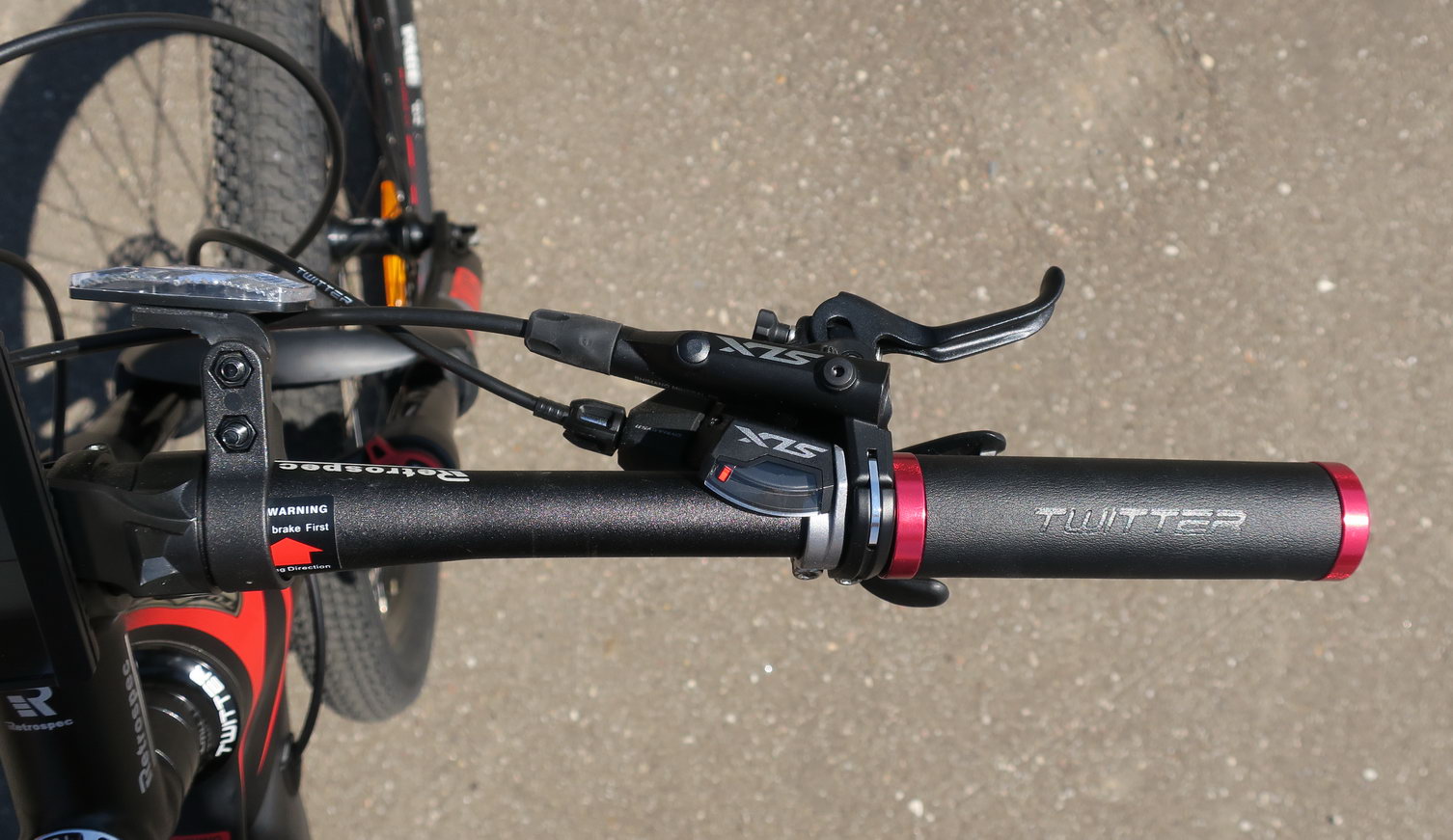

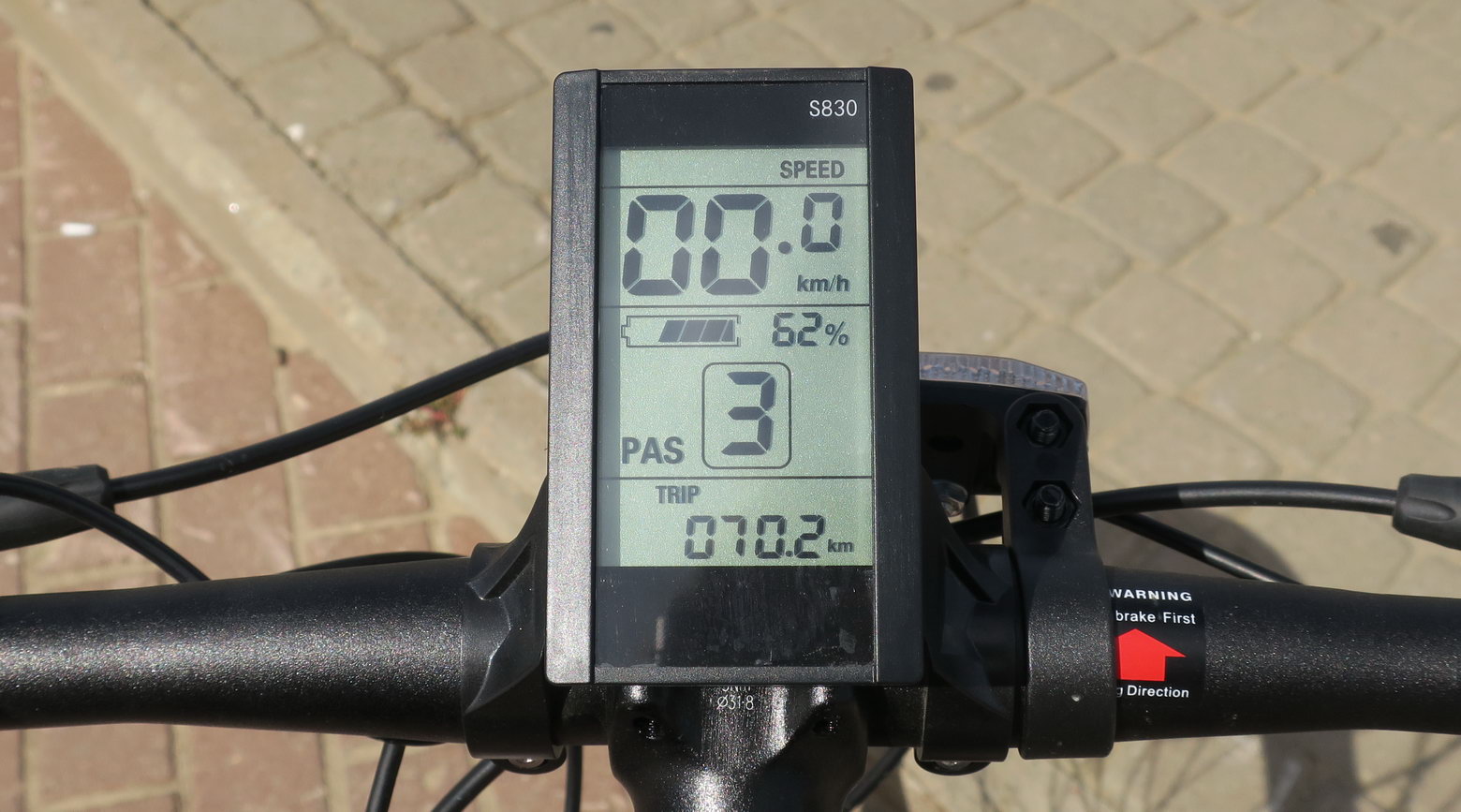
There are two features on the steering wheel trim.
Firstly, on the left side is a small three-button bicycle electric control panel.
They are enough to control all modes, as well as turn the bike on and off.
The second feature is the monitor in the center of the steering wheel. It has a large screen with good image visibility in any light (you can turn on the backlight at night).
The monitor constantly displays the speed and charge of the battery, and it is also possible to display the distance of the current trip, its duration, odometer (total mileage of the bike), and even such “subtleties” as current and battery voltage.
The front wheel is, in general, ordinary. Tires are moderately wide (1.95 inches), universal (suitable for asphalt plus not too “heavy” soils).
Let's pay attention to the plug and its damper:
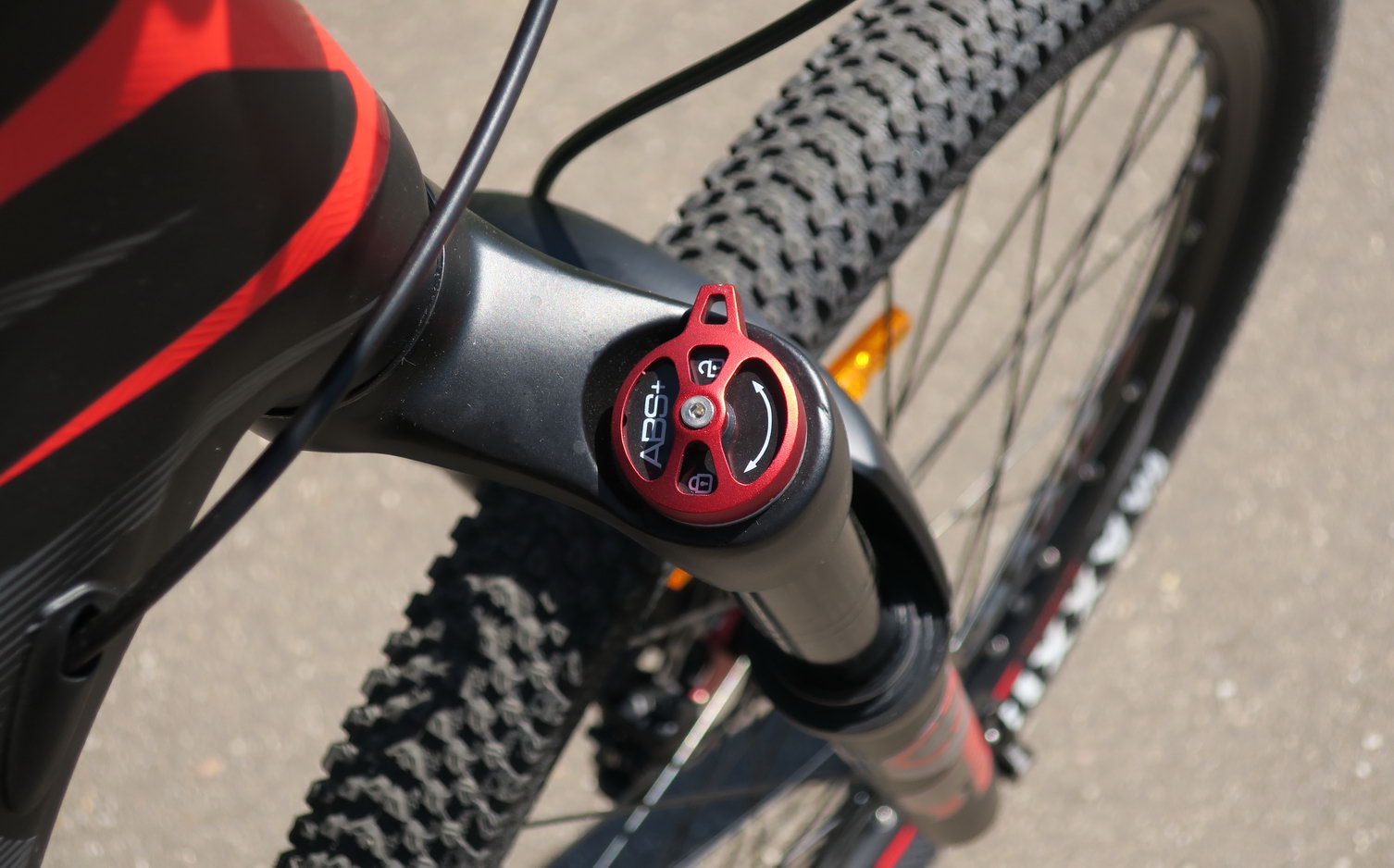
The stroke of the plug is 110 mm, the popular “ABS +” is used as a damper.
This is an air-oil damper. Air acts as a spring, and oil dampens vibrations.
The damper has 6 damping settings plus a closed position (for good roads).
The rear wheel of the bike is made in the form of a motor wheel. The motor itself is rather small-sized for its power, and in diameter it does not go beyond the dimensions of the sprockets:
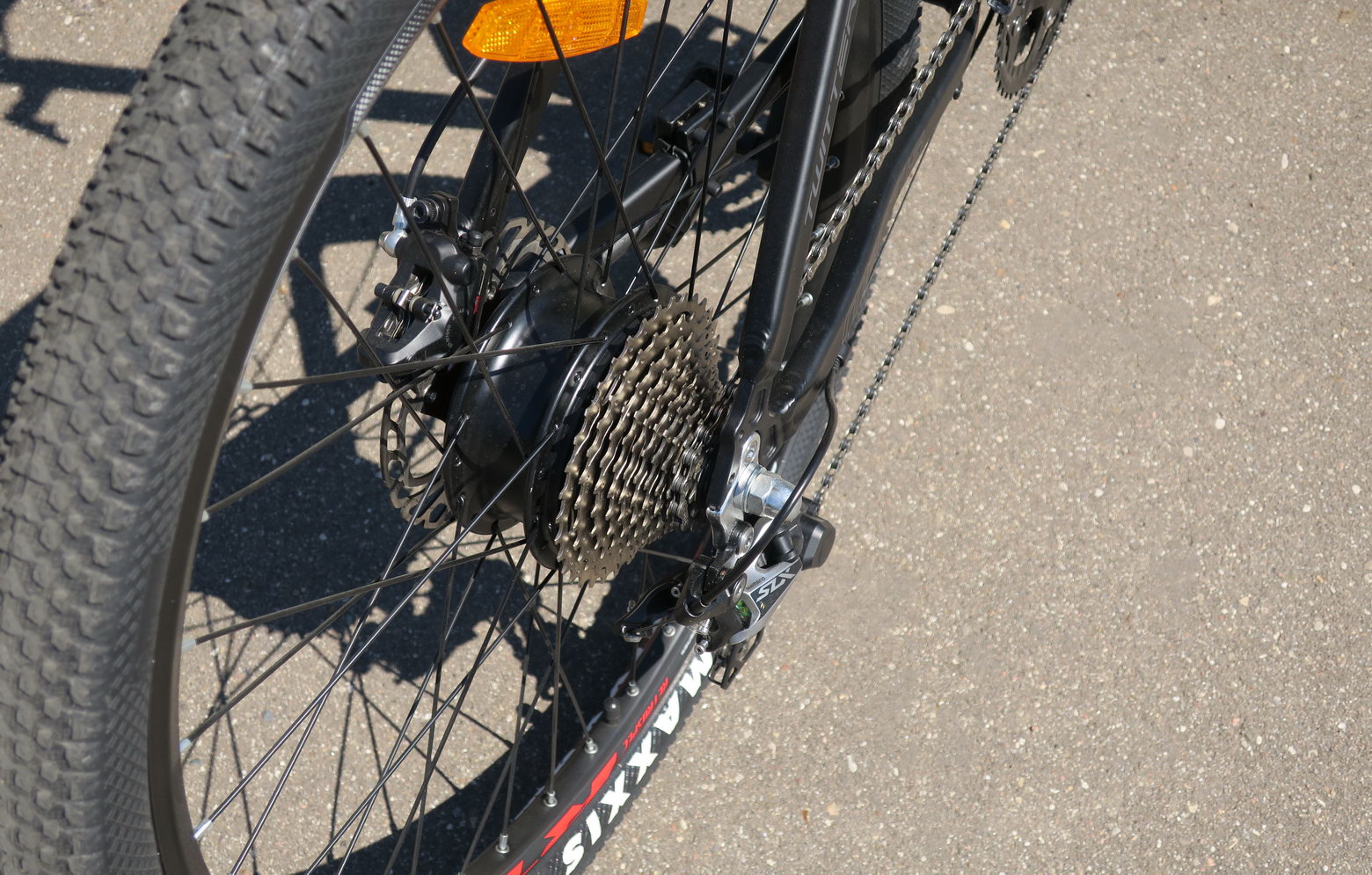
All the brakes and gearshifts are of a very good level, Shimano SLX. By the way, the brakes are hydraulic.
And finally, the pedals. The pedals here are combined, they can be used as “contact” pedals (firmly engage with shoes), as well as ordinary “treadmills”:
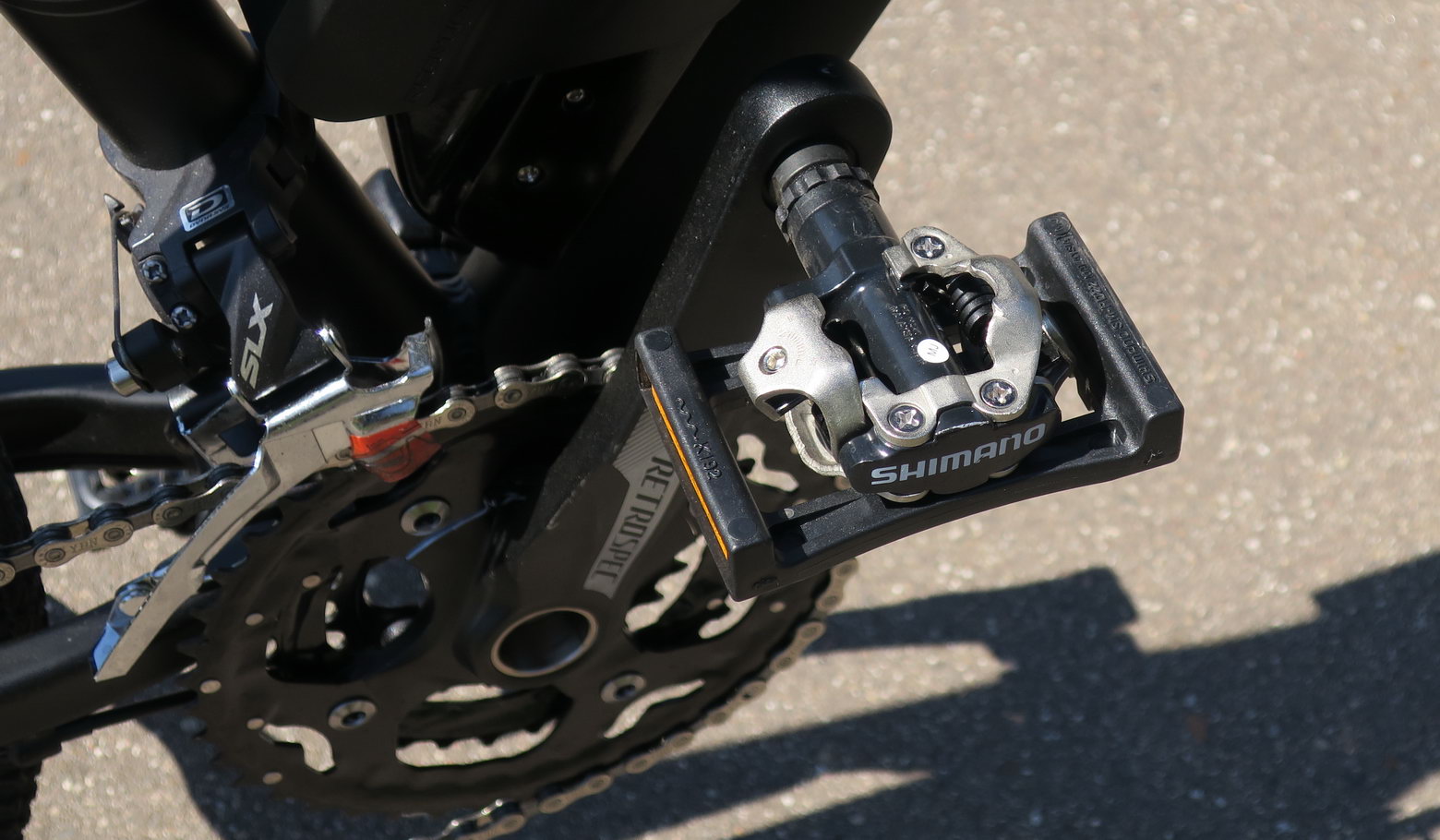
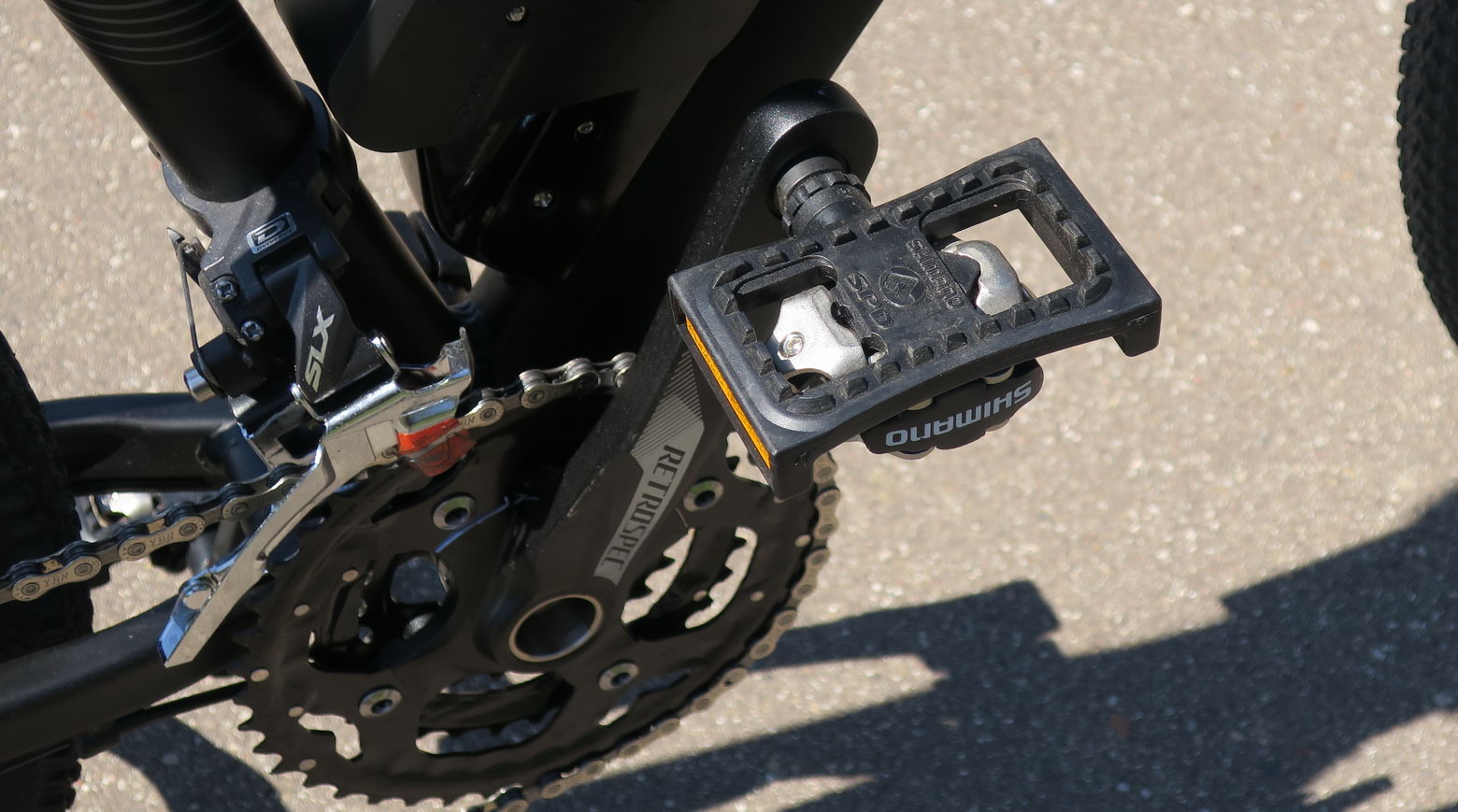
Summing up the analysis of the design, we can conclude from where this electric bike has such a high price (I recall 119,990 rubles) .
The price turned out to be this not only and not so much because of the presence of a powerful electric drive and a capacious battery, but also because of the “advanced” mechanical bicycle components (which also cost a lot). And, of course, duties, taxes, profits of trading and transport organizations are also included in the price.
Bicycle driving performance Twitter Mantis-E1 The
motor of this electric bike turns on and works only in the help mode (when the cyclist pedals). Or, more precisely, mutual assistance, since it is impossible to say exactly who helps someone - a motor cyclist or vice versa.
Moreover, pedaling in the "lazy" style (following the course of the bike, with zero pressure on the pedals) here does not "ride" in every sense of the word. The pressure on the pedals should be required, at least a little. A freebie will not work!
Accordingly, for very “lazy" users, such a bike would not be suitable.
Using the control panel of 3 buttons and a monitor, the cyclist can assign one of five levels of assistance. These levels work quite logically, and the higher the level, the more the motor will help the rider.
It should be noted a difficult algorithm of the bicycle; It has several features.
Since the motor is powerful, so that the bike does not leave the rider at the start, smooth acceleration of the bike is introduced in the algorithm. When traveling on flat terrain, this part of the algorithm is not even felt, it is so naturally implemented.
But when riding uphill with the wrong behavior of the rider, smooth acceleration can play a bad joke with the rider. As soon as the rider at the entrance to the mountain stop pedaling for at least a second, the bicycle switches back to smooth acceleration mode.
And to accelerate uphill is far from the “pleasure” that cyclists dream of! Moreover, at the time of acceleration, the motor is still far from full power, and the cyclist himself will have to make the main effort.
The next feature is a decrease in motor power when approaching the maximum speed specified by the manufacturer (35 km / h).
The decrease begins a little earlier than this value (approximately at the level of 31-33 km / h), and the decrease occurs gradually and is initially invisible to the user. At a speed of 35 km / h, the decrease is already significant; and at a speed of 37-38 km / h power is not supplied to the motor at all.
That is, if you want to accelerate above 37 km / h, you can only do this “on your own”, the motor will not help you. This is not a bad thing, it is the manufacturer's safety concern.
And finally, checking the range on a single charge (the manufacturer claimed 120 km).
Due to the very long range, it was not possible to verify this value at a time.
In a comfortable trip mode (mainly the 3rd level of assistance, adjusted to 4-5 when driving uphill), we managed to drive 103 km in the first day. At the same time, I estimate my own contribution to the "energy" of the trip at about ⅓.
Since the battery still had 36% of the charge, the next day I had to “twist” this remaining charge, and it was enough for another 24 km.
By the way, in these trips, a drawback was revealed: a non-linear graph of battery consumption readings. At first, the monitor for a long time at the beginning of the trip showed 100% of the charge (over 20 km), and only then it began to show a discharge. That is, there is an overstatement of evidence (mentally it is necessary to reduce them).
Conclusions on the electric bike Twitter Mantis-E1
The following model of the first part of the review:
This model is the most expensive of those reviewed in this article: as many as 144 thousand Russian rubles! As Zhvanetsky would say: “Explain why ?!”
As in the Twitter Mantis-E1 model, the main part of the price does not fall on the electric drive and the associated “strapping”, but on expensive bicycle components; and of these, the most expensive component is the carbon frame.
The carbon frame performs two functions at the same time: firstly, it allows you to slightly facilitate the design; secondly, it gives the bike a very aesthetic look. The latter is obtained “automatically”, since all parts of the frame are made in one cycle and some elements of the frame smoothly pass into others (without welding, bolt connections, etc.).
Additional aesthetics to the bicycle are given by the absence of a separate battery pack: the battery and controllers are also hidden in the frame.
The main technical parameters of the Twitter TW-E9L electric bike:
Wheels - 26 ", double pistonated rim
. Bicycle weight - 18 kg.
Frame - carbon fiber, universal
fork - aluminum-magnesium alloy, damper with step compression adjustment (6 levels +" closed ")
Gear selector ( rear only) - Shimano SLX, 11 speeds
Brakes - disc hydraulic, Shimano M315
Tires - MICHELIN Country
Usage modes- help mode and pedal mode (there is no driving mode only by motor power)
Electric drive parameters :
Number of help mode levels - 5
Battery - 36 Volts, 10 Amp-hours
Motor - integrated into the frame, brushless, 250 W
Maximum speed - 35 km / h
Mileage 90 km on a single charge (in help mode)
Dashboard - LCD monitor
All the parameters are on the bike’s specifications page .
The appearance of the electric bike on the right and left:


The rigidity of the structure is determined by the lower triangle of the frame. Thanks to this triangle, at the same time, the bicycle becomes universal - it is suitable for cyclists of any gender and height.
One of the key features of the bike (in addition to the carbon frame) is its electric drive.
If in the vast majority of other bicycles the electric drive is implemented in the form of a motor wheel, then here the motor is built into the frame and combined with the carriage (the so-called “carriage motor”).
Such a design is more complicated than a conventional motor-wheel, and a logical question arises - why?
The answer lies in the laws of mechanics.
If the engine is made in the form of a motor wheel, then such an engine itself does not have a gear shift. The gearbox available there operates with a fixed gear ratio, and cannot react in any way to changing road conditions.
If a rider, for example, when climbing uphill, switches the mechanics to a lower speed for optimal lifting, then nothing changes in the motor wheel, and the motor is in an unfavorable energy mode.
In contrast, when the motor is combined with the carriage, the gear change will be “valid” for both the motor and the rider. And this in a situation of "heavy" road will facilitate the work of both the rider and the motor. As a result, both the rider and the motor will be less loaded; and riding a bike uphill will be faster!
The main thing is that the user does not forget when riding uphill (and on other "difficult" roads) to switch the speed to a lower speed, as cyclists usually do. Often users of electric bikes, enjoying the help of an electric motor, forget that switching mechanical speeds in electric bikes is by no means done for beauty. :)
Of course, a bicycle will still not be able to drive along a vertical wall (or at least at 30-45 °), but tests have shown the effectiveness of such a system on roads even with very steep climbs.
Another advantage of the carriage motor is that it does not shift the center of gravity of the bicycle (and a conventional motor-wheel shifts the center towards the wheel in which it is built). This allows you to more familiar and easier to overcome the small obstacles encountered on the way.
After this detailed “stop” regarding the motor, we continue to inspect the bicycle.
The saddle is sporty in appearance (and they are usually quite rigid), but in fact it is quite soft and comfortable for "civilian" cyclists:

The height of the saddle is adjusted using a clamp, which is fixed not with an eccentric, but with a hexagon screw (key in bike kit available).
Let's take a look at the steering wheel: The
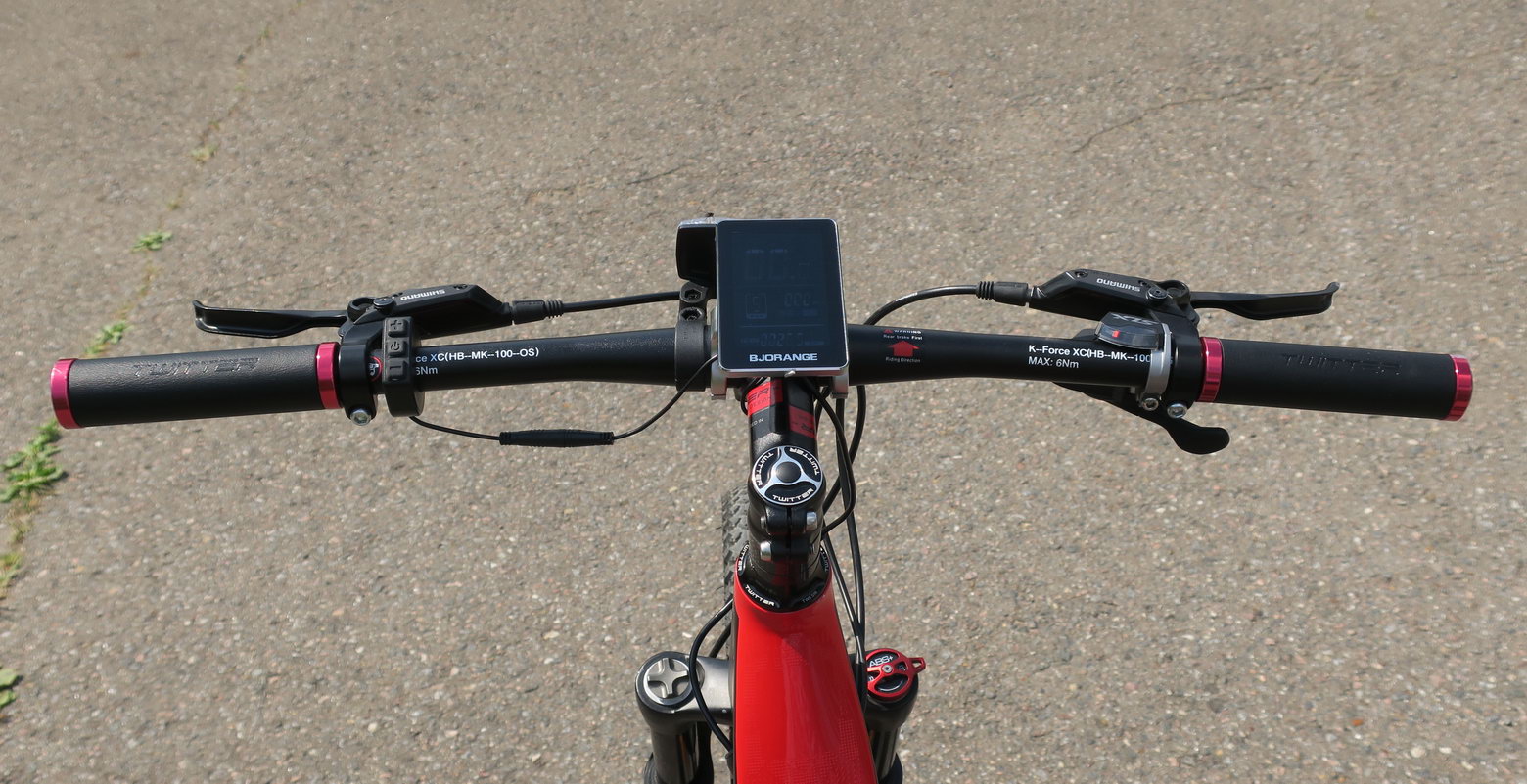
steering wheel differs from the standard bicycle steering wheel by the presence of two additional parts: on the left side there is a miniature “control panel” with three buttons, and in the center of the steering wheel there is a “dashboard” (bike computer monitor).
The bike computer monitor is an LCD display that looks like a smartphone screen from afar:
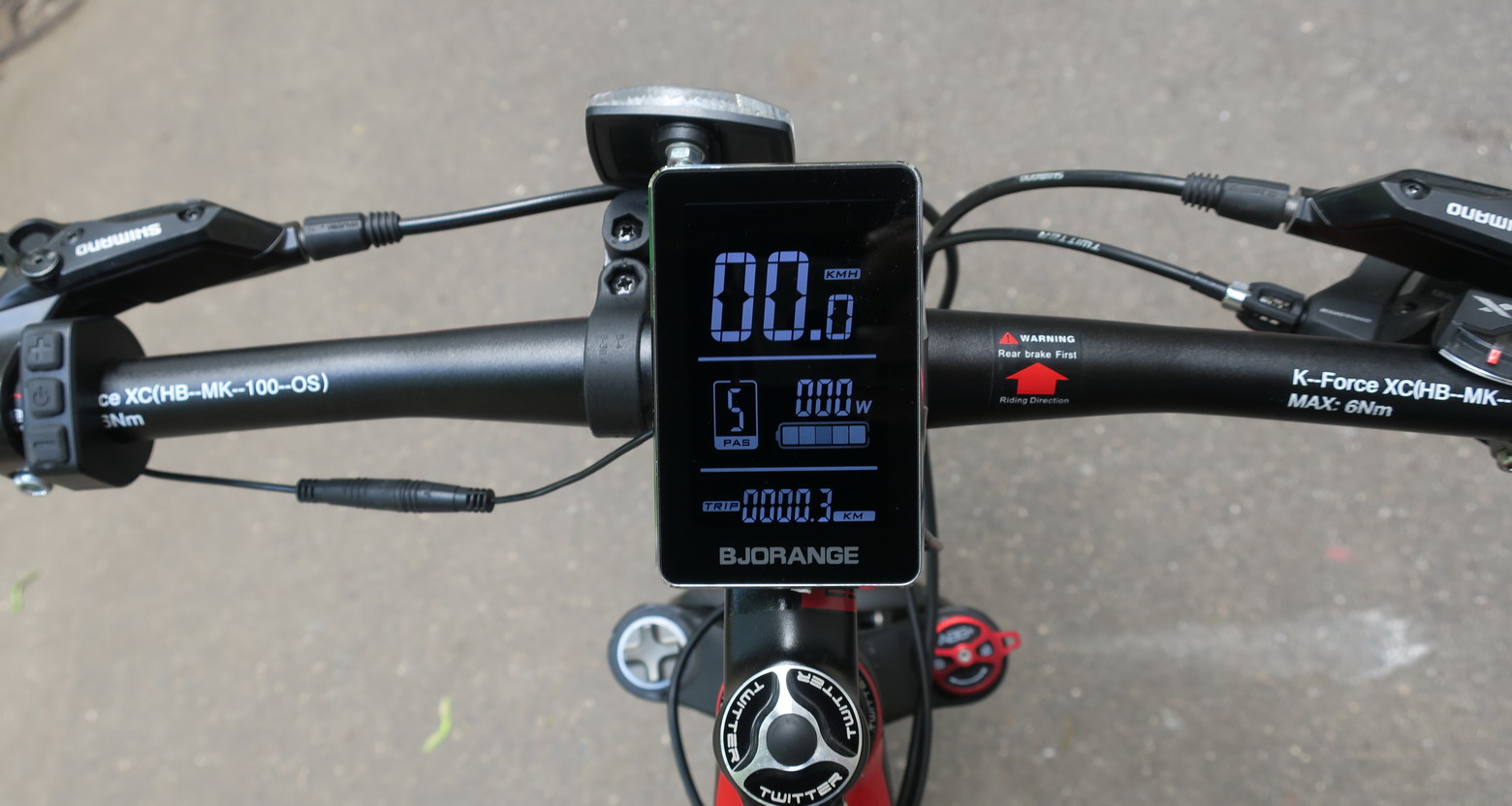
Unfortunately, like on a smartphone, on this display on a bright sunny day, the contrast of the image drops dramatically; it becomes barely distinguishable.
The display shows the distance of the current trip, current speed, power on the motor, battery charge and the set level of assistance. If the help level is set to zero, then this is the pedal mode.
Instead of showing the distance of the current trip, you can display the odometer readings on the monitor (the full distance traveled by the bicycle from the moment it was first turned on).
As for help levels, they have their own algorithm of work. It must be understood by the user in order to use the bike correctly.
When the user starts to pedal, after about 1-2 turns, the motor turns on and helps the user.
The power supplied to the motor, at first (with moderate acceleration) is proportional to the speed of rotation of the pedals (but not the force of pressure on them!).
Then, when the capacity reaches the limit for the established level of assistance, further growth stops.
If the user is persistent and continues to increase efforts further, then the power on the motor can even decrease, giving the user the opportunity to independently show his strength and distance. :)
Control races showed that at the minimum (first) level of assistance, power can be up to 12 watts, at the maximum - 168 watts (according to the monitor).
It follows from this that the first level of assistance is not very working and differs little from the self-pedaling mode. But all the other levels are working and useful for use.
Addition to what has just been said: the readings of the current power on the bike are underestimated. Sea trials have shown that the motor can roll a bicycle at full declared 250 watts, which, apparently, correspond to the display readings of 168 watts. Otherwise, speeds above 25-27 km / h would have been impossible to achieve only on the strength of the motor. Multiply the power readings on the monitor immediately by one and a half - do not be mistaken!
We examine the bicycle further - the front wheel and surroundings: The

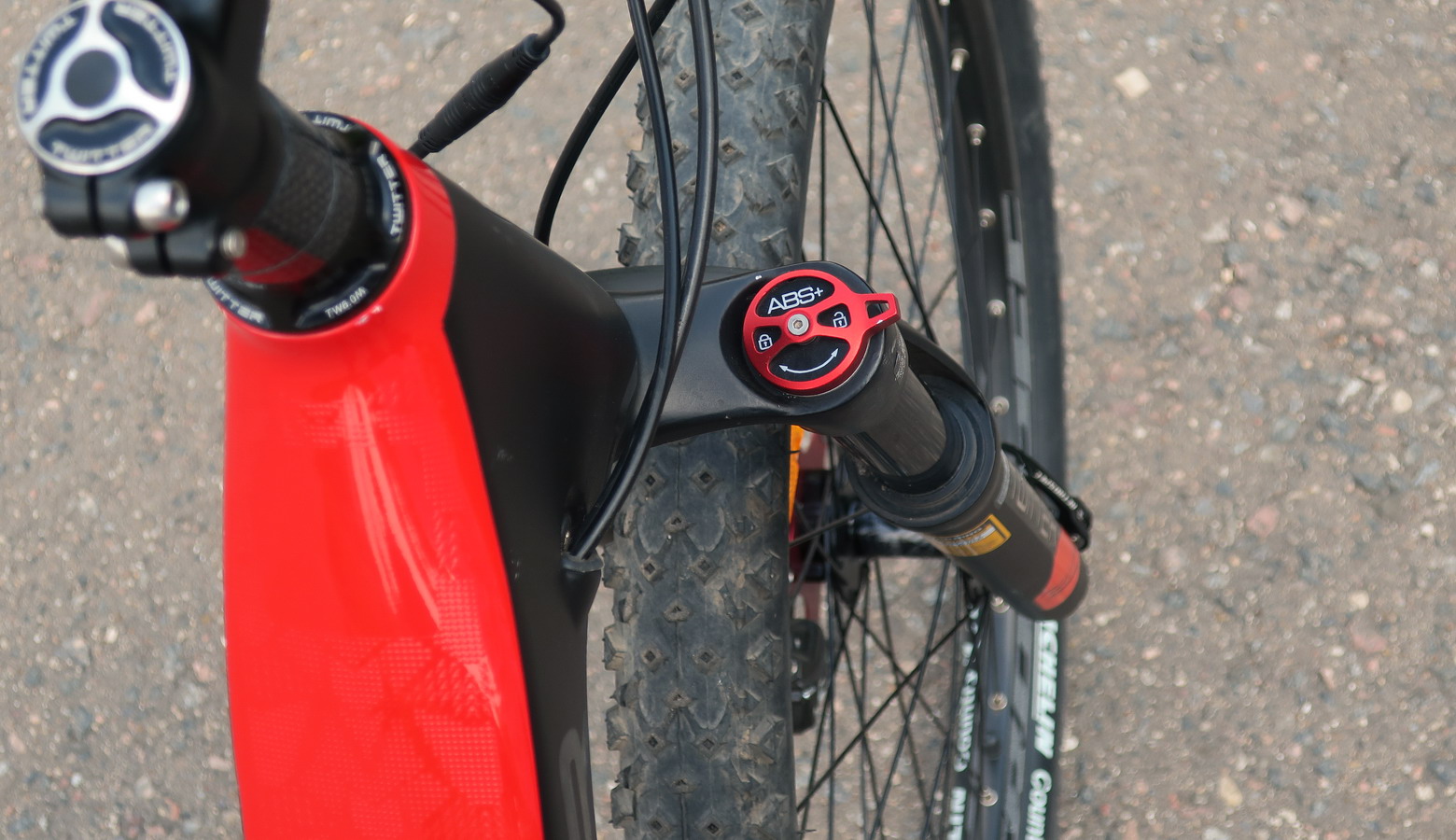
front wheel is solid, with a double rimmed piston. Disc brake - advanced, hydraulic Shimano M315 (for mountain bikes). This brake is not only advanced, but also beautiful by adding a colored element to the brake disc itself.
Front wheel fork - with adjustable damping (6 steps plus closed position). Damping adjustment is useful for "tuning" to the quality of the road. As you know, our place is called the place where they are going to drive; so damping will not be superfluous. The fork travel is good (110 mm).
By the way, thanks to the wide wheels with moderate tread ribbing, a path along dirt tracks with a certain amount of dirt is also possible.
At the same time, when driving on the highway, you can hardly hear the characteristic rustling that usually happens on wheels with too “bad” tires, and which annoys many people.
The rear wheel, like the front one, has no significant differences in design from standard options.

The brake, of course, is of the same type as on the front wheel - Shimano M315. Speed selector - Shimano SLX.
Also, a magnet is installed on the spoke of the rear wheel, with the help of which a speed sensor works, attached to the inside of the lower feather of the frame. Bicycles with a motor wheel do not have such a sensor; the motor itself is the speed sensor there.
Next - pay attention to the pedals: The

pedals are thin, beautiful and spiked. Shoes hold well, but you should try not to touch them with your feet when you are walking next to a bicycle.
Driving performance of the Twitter TW-E9L electric bike
Although its engine formally operates only in the help mode (it cannot be turned on without forcing pedals), but, nevertheless, the bike can be made to ride almost on a single motor.
This is not difficult to achieve, since it turns on the motor upon the fact of pedaling, even without pressure on them. It is only necessary to drive a little with active pedaling, and then it is enough to tighten them lazily, if only the bicycle “thinks” that you are working. :)
But this is not the mode for which the bike is intended. The most reasonable and useful mode is the joint work of the motor and the cyclist.
The most appropriate help levels for this are from 2nd to 4th.
As already mentioned, at the 1st aid level, the motor does very little help to the Katals, but at the 5th level, on the contrary, the motor works very powerfully, and it will be difficult for the rider to turn the pedals not at idle, but helping the motor.
At the 5th level of assistance, the motor easily accelerates the bike to 32 km / h on a good road; but in order to increase the speed to 35 kph / h, promised by the manufacturer, the cyclist needs to sweat well already.
True, on the climbs of a steep mountain, a cyclist will have a real opportunity to help the motor with his own strength even at the 5th level of help.
Another very important question for any electric vehicle is how much you can travel on one charge.
But for bicycles operating only in assistance mode, a clear answer to this question does not exist; since everything will depend on how actively the rider will help the motor.
Nevertheless, tests were carried out, and there is an answer to this question.
On a trip in the “economy” mode (speed of 18-20 km / h, assistance from the cyclist to the motor at about 50%), the range was 93 km.
During the trip in “comfortable” mode (speed 20-25 km / h, assistance from the cyclist to the motor at about около), the range was 65 km.
If I take me for the "average" Katalz (in strength and mass), then for most other users there should be similar numbers.
Conclusions on the electric bike Twitter TW-E9L
According to the results of the inspection and test, two conclusions suggest themselves :
In the next part of the review (coming out in about 3 days) you will get acquainted with three less expensive models of electric bikes:
- Twitter VS7.0-ER (350 W);
- Airwheel R8 (235 watts);
- Airwheel R3 (235 watts).
But they are not highlighted in a separate part of the review because they are less expensive; but for the fact that these are “lazy” models. They have a lever to turn on the motor, thanks to which you can ride them if you wish without any pedal rider!
See you!
The advantage of electric scooters is compactness, but they have one very severe limitation: according to the rules of the road (SDA), they are equated with pedestrians and have the right to ride only on sidewalks.
In this regard, they are very good for leisurely trips over short distances; and over long distances they are significantly inferior to electric bicycles, which move faster due to the ability to move on highways (except for those where it is forbidden).
This article (in two parts) will briefly describe and present the test results of five models of electric bikes from two manufacturers. Of course, they do not cover all the variety of existing models of electric bicycles, but the most “typical cases" are well represented. This will help orient the future owner of the electric bike in possible options and realize which bike is suitable for him.

Among the monitored are two models in which the electric motor serves as a means of help and turns on only if the cyclist turns the pedals; and three models in which the motor can work completely autonomously. Conventionally, we call the first group “for the lazy”, and the second group - “for the lazy”.
Let's start with the first group (this will be the first part of the review). Two models will be considered here:Twitter Mantis-E1 and Twitter TW-E9L .
Electric bike Twitter Mantis-E1
The model is made in Shenzhen, the center of the Chinese electronic industry, and has nothing to do with the social network Twitter.
You can even say that they called their products in vain: according to Twitter, finding a social network on the Internet is much easier than a bicycle manufacturer. But this does not affect the driving performance of the bike.
The model is a powerful (350 W) electric bike with a “classic” design, including a motor wheel and a battery pack.
The word “powerful” was not used accidentally: according to the SDA, this model is no longer an electric bike, but an electric pedologist; since electric bicycles are considered devices with a power of only up to 250 watts. But externally, the model is no different from bicycles, so in the review it will still be called an electric bike.
Let's look at it in a general view (right and left):


Before further narration, we will familiarize ourselves with the main technical parameters of an electric bike :
Wheels - 26 ", double pistoned rim.
Mass of the bike - 17.9 kg
Frame - aluminum, 15.5" / 17 "
Plug - aluminum-magnesium alloy , damper with step adjustment of compression (6 levels + "closed")
Gear shifters- Shimano SLX, 33 speeds, (11 * 3)
Brakes - hydraulic disc, Shimano SLX
Tires - MAXXIS-PACE, 26 "× 1.95"
Use modes - help mode and pedal mode (there is no driving mode only by motor power)
Electric drive parameters:
Quantity help mode levels - 5
Battery - removable, 36 Volt, 13 Amp-hours
Motor - rear motor-wheel, brushless, 350 W
Maximum speed - 35 km / h
Mileage on a single charge - up to 120 km (in help mode)
Dashboard - LCD display
All the parameters are available on the bike’s specifications page .
The price of a bicycle is 119990 rubles, but some sellers sell 5 thousand more.
Let's look at the center of the bike with the saddle:

First, look at the crosshairs of the frame parts under the saddle. Pay attention to their smooth connection.
The manufacturer calls this connection “seamless welding”. In fact, welding is the most common there, but the seams are smoothed and polished, which gives the electric bike a beautiful, modern look.
The saddle is moderately stiff, close to sports. Some owners will need some getting used to, but no replacement is required.
The battery pack has a lid, behind which there are connectors and a switch:

The USB connector is designed to recharge mobile devices from this unit on halts; and a round connector - for charging the battery pack itself.
Due to the fact that the battery pack is removable, it can be charged separately from the bicycle (in some cases it can be convenient).
We'll look at the steering wheel of an electric bike in three ways: the right side, the left, and the center:



There are two features on the steering wheel trim.
Firstly, on the left side is a small three-button bicycle electric control panel.
They are enough to control all modes, as well as turn the bike on and off.
The second feature is the monitor in the center of the steering wheel. It has a large screen with good image visibility in any light (you can turn on the backlight at night).
The monitor constantly displays the speed and charge of the battery, and it is also possible to display the distance of the current trip, its duration, odometer (total mileage of the bike), and even such “subtleties” as current and battery voltage.
The front wheel is, in general, ordinary. Tires are moderately wide (1.95 inches), universal (suitable for asphalt plus not too “heavy” soils).
Let's pay attention to the plug and its damper:

The stroke of the plug is 110 mm, the popular “ABS +” is used as a damper.
This is an air-oil damper. Air acts as a spring, and oil dampens vibrations.
The damper has 6 damping settings plus a closed position (for good roads).
The rear wheel of the bike is made in the form of a motor wheel. The motor itself is rather small-sized for its power, and in diameter it does not go beyond the dimensions of the sprockets:

All the brakes and gearshifts are of a very good level, Shimano SLX. By the way, the brakes are hydraulic.
And finally, the pedals. The pedals here are combined, they can be used as “contact” pedals (firmly engage with shoes), as well as ordinary “treadmills”:


Summing up the analysis of the design, we can conclude from where this electric bike has such a high price (I recall 119,990 rubles) .
The price turned out to be this not only and not so much because of the presence of a powerful electric drive and a capacious battery, but also because of the “advanced” mechanical bicycle components (which also cost a lot). And, of course, duties, taxes, profits of trading and transport organizations are also included in the price.
Bicycle driving performance Twitter Mantis-E1 The
motor of this electric bike turns on and works only in the help mode (when the cyclist pedals). Or, more precisely, mutual assistance, since it is impossible to say exactly who helps someone - a motor cyclist or vice versa.
Moreover, pedaling in the "lazy" style (following the course of the bike, with zero pressure on the pedals) here does not "ride" in every sense of the word. The pressure on the pedals should be required, at least a little. A freebie will not work!
Accordingly, for very “lazy" users, such a bike would not be suitable.
Using the control panel of 3 buttons and a monitor, the cyclist can assign one of five levels of assistance. These levels work quite logically, and the higher the level, the more the motor will help the rider.
It should be noted a difficult algorithm of the bicycle; It has several features.
Since the motor is powerful, so that the bike does not leave the rider at the start, smooth acceleration of the bike is introduced in the algorithm. When traveling on flat terrain, this part of the algorithm is not even felt, it is so naturally implemented.
But when riding uphill with the wrong behavior of the rider, smooth acceleration can play a bad joke with the rider. As soon as the rider at the entrance to the mountain stop pedaling for at least a second, the bicycle switches back to smooth acceleration mode.
And to accelerate uphill is far from the “pleasure” that cyclists dream of! Moreover, at the time of acceleration, the motor is still far from full power, and the cyclist himself will have to make the main effort.
The next feature is a decrease in motor power when approaching the maximum speed specified by the manufacturer (35 km / h).
The decrease begins a little earlier than this value (approximately at the level of 31-33 km / h), and the decrease occurs gradually and is initially invisible to the user. At a speed of 35 km / h, the decrease is already significant; and at a speed of 37-38 km / h power is not supplied to the motor at all.
That is, if you want to accelerate above 37 km / h, you can only do this “on your own”, the motor will not help you. This is not a bad thing, it is the manufacturer's safety concern.
And finally, checking the range on a single charge (the manufacturer claimed 120 km).
Due to the very long range, it was not possible to verify this value at a time.
In a comfortable trip mode (mainly the 3rd level of assistance, adjusted to 4-5 when driving uphill), we managed to drive 103 km in the first day. At the same time, I estimate my own contribution to the "energy" of the trip at about ⅓.
Since the battery still had 36% of the charge, the next day I had to “twist” this remaining charge, and it was enough for another 24 km.
By the way, in these trips, a drawback was revealed: a non-linear graph of battery consumption readings. At first, the monitor for a long time at the beginning of the trip showed 100% of the charge (over 20 km), and only then it began to show a discharge. That is, there is an overstatement of evidence (mentally it is necessary to reduce them).
Conclusions on the electric bike Twitter Mantis-E1
- The electric bike has excellent bicycle mechanics proper, designed for users who are inclined to make some real effort while riding.
- The bike has a powerful motor and a very high range on a single charge. In this regard, it is recommended to use it for long trips with good speed; and for simple trips in the parks, bike opportunities will be overpriced.
The following model of the first part of the review:
Electric Bike Twitter TW-E9L
This model is the most expensive of those reviewed in this article: as many as 144 thousand Russian rubles! As Zhvanetsky would say: “Explain why ?!”
As in the Twitter Mantis-E1 model, the main part of the price does not fall on the electric drive and the associated “strapping”, but on expensive bicycle components; and of these, the most expensive component is the carbon frame.
The carbon frame performs two functions at the same time: firstly, it allows you to slightly facilitate the design; secondly, it gives the bike a very aesthetic look. The latter is obtained “automatically”, since all parts of the frame are made in one cycle and some elements of the frame smoothly pass into others (without welding, bolt connections, etc.).
Additional aesthetics to the bicycle are given by the absence of a separate battery pack: the battery and controllers are also hidden in the frame.
The main technical parameters of the Twitter TW-E9L electric bike:
Wheels - 26 ", double pistonated rim
. Bicycle weight - 18 kg.
Frame - carbon fiber, universal
fork - aluminum-magnesium alloy, damper with step compression adjustment (6 levels +" closed ")
Gear selector ( rear only) - Shimano SLX, 11 speeds
Brakes - disc hydraulic, Shimano M315
Tires - MICHELIN Country
Usage modes- help mode and pedal mode (there is no driving mode only by motor power)
Electric drive parameters :
Number of help mode levels - 5
Battery - 36 Volts, 10 Amp-hours
Motor - integrated into the frame, brushless, 250 W
Maximum speed - 35 km / h
Mileage 90 km on a single charge (in help mode)
Dashboard - LCD monitor
All the parameters are on the bike’s specifications page .
The appearance of the electric bike on the right and left:


The rigidity of the structure is determined by the lower triangle of the frame. Thanks to this triangle, at the same time, the bicycle becomes universal - it is suitable for cyclists of any gender and height.
One of the key features of the bike (in addition to the carbon frame) is its electric drive.
If in the vast majority of other bicycles the electric drive is implemented in the form of a motor wheel, then here the motor is built into the frame and combined with the carriage (the so-called “carriage motor”).
Such a design is more complicated than a conventional motor-wheel, and a logical question arises - why?
The answer lies in the laws of mechanics.
If the engine is made in the form of a motor wheel, then such an engine itself does not have a gear shift. The gearbox available there operates with a fixed gear ratio, and cannot react in any way to changing road conditions.
If a rider, for example, when climbing uphill, switches the mechanics to a lower speed for optimal lifting, then nothing changes in the motor wheel, and the motor is in an unfavorable energy mode.
In contrast, when the motor is combined with the carriage, the gear change will be “valid” for both the motor and the rider. And this in a situation of "heavy" road will facilitate the work of both the rider and the motor. As a result, both the rider and the motor will be less loaded; and riding a bike uphill will be faster!
The main thing is that the user does not forget when riding uphill (and on other "difficult" roads) to switch the speed to a lower speed, as cyclists usually do. Often users of electric bikes, enjoying the help of an electric motor, forget that switching mechanical speeds in electric bikes is by no means done for beauty. :)
Of course, a bicycle will still not be able to drive along a vertical wall (or at least at 30-45 °), but tests have shown the effectiveness of such a system on roads even with very steep climbs.
Another advantage of the carriage motor is that it does not shift the center of gravity of the bicycle (and a conventional motor-wheel shifts the center towards the wheel in which it is built). This allows you to more familiar and easier to overcome the small obstacles encountered on the way.
After this detailed “stop” regarding the motor, we continue to inspect the bicycle.
The saddle is sporty in appearance (and they are usually quite rigid), but in fact it is quite soft and comfortable for "civilian" cyclists:

The height of the saddle is adjusted using a clamp, which is fixed not with an eccentric, but with a hexagon screw (key in bike kit available).
Let's take a look at the steering wheel: The

steering wheel differs from the standard bicycle steering wheel by the presence of two additional parts: on the left side there is a miniature “control panel” with three buttons, and in the center of the steering wheel there is a “dashboard” (bike computer monitor).
The bike computer monitor is an LCD display that looks like a smartphone screen from afar:

Unfortunately, like on a smartphone, on this display on a bright sunny day, the contrast of the image drops dramatically; it becomes barely distinguishable.
The display shows the distance of the current trip, current speed, power on the motor, battery charge and the set level of assistance. If the help level is set to zero, then this is the pedal mode.
Instead of showing the distance of the current trip, you can display the odometer readings on the monitor (the full distance traveled by the bicycle from the moment it was first turned on).
As for help levels, they have their own algorithm of work. It must be understood by the user in order to use the bike correctly.
When the user starts to pedal, after about 1-2 turns, the motor turns on and helps the user.
The power supplied to the motor, at first (with moderate acceleration) is proportional to the speed of rotation of the pedals (but not the force of pressure on them!).
Then, when the capacity reaches the limit for the established level of assistance, further growth stops.
If the user is persistent and continues to increase efforts further, then the power on the motor can even decrease, giving the user the opportunity to independently show his strength and distance. :)
Control races showed that at the minimum (first) level of assistance, power can be up to 12 watts, at the maximum - 168 watts (according to the monitor).
It follows from this that the first level of assistance is not very working and differs little from the self-pedaling mode. But all the other levels are working and useful for use.
Addition to what has just been said: the readings of the current power on the bike are underestimated. Sea trials have shown that the motor can roll a bicycle at full declared 250 watts, which, apparently, correspond to the display readings of 168 watts. Otherwise, speeds above 25-27 km / h would have been impossible to achieve only on the strength of the motor. Multiply the power readings on the monitor immediately by one and a half - do not be mistaken!
We examine the bicycle further - the front wheel and surroundings: The


front wheel is solid, with a double rimmed piston. Disc brake - advanced, hydraulic Shimano M315 (for mountain bikes). This brake is not only advanced, but also beautiful by adding a colored element to the brake disc itself.
Front wheel fork - with adjustable damping (6 steps plus closed position). Damping adjustment is useful for "tuning" to the quality of the road. As you know, our place is called the place where they are going to drive; so damping will not be superfluous. The fork travel is good (110 mm).
By the way, thanks to the wide wheels with moderate tread ribbing, a path along dirt tracks with a certain amount of dirt is also possible.
At the same time, when driving on the highway, you can hardly hear the characteristic rustling that usually happens on wheels with too “bad” tires, and which annoys many people.
The rear wheel, like the front one, has no significant differences in design from standard options.

The brake, of course, is of the same type as on the front wheel - Shimano M315. Speed selector - Shimano SLX.
Also, a magnet is installed on the spoke of the rear wheel, with the help of which a speed sensor works, attached to the inside of the lower feather of the frame. Bicycles with a motor wheel do not have such a sensor; the motor itself is the speed sensor there.
Next - pay attention to the pedals: The

pedals are thin, beautiful and spiked. Shoes hold well, but you should try not to touch them with your feet when you are walking next to a bicycle.
Driving performance of the Twitter TW-E9L electric bike
Although its engine formally operates only in the help mode (it cannot be turned on without forcing pedals), but, nevertheless, the bike can be made to ride almost on a single motor.
This is not difficult to achieve, since it turns on the motor upon the fact of pedaling, even without pressure on them. It is only necessary to drive a little with active pedaling, and then it is enough to tighten them lazily, if only the bicycle “thinks” that you are working. :)
But this is not the mode for which the bike is intended. The most reasonable and useful mode is the joint work of the motor and the cyclist.
The most appropriate help levels for this are from 2nd to 4th.
As already mentioned, at the 1st aid level, the motor does very little help to the Katals, but at the 5th level, on the contrary, the motor works very powerfully, and it will be difficult for the rider to turn the pedals not at idle, but helping the motor.
At the 5th level of assistance, the motor easily accelerates the bike to 32 km / h on a good road; but in order to increase the speed to 35 kph / h, promised by the manufacturer, the cyclist needs to sweat well already.
True, on the climbs of a steep mountain, a cyclist will have a real opportunity to help the motor with his own strength even at the 5th level of help.
Another very important question for any electric vehicle is how much you can travel on one charge.
But for bicycles operating only in assistance mode, a clear answer to this question does not exist; since everything will depend on how actively the rider will help the motor.
Nevertheless, tests were carried out, and there is an answer to this question.
On a trip in the “economy” mode (speed of 18-20 km / h, assistance from the cyclist to the motor at about 50%), the range was 93 km.
During the trip in “comfortable” mode (speed 20-25 km / h, assistance from the cyclist to the motor at about около), the range was 65 km.
If I take me for the "average" Katalz (in strength and mass), then for most other users there should be similar numbers.
Conclusions on the electric bike Twitter TW-E9L
According to the results of the inspection and test, two conclusions suggest themselves :
- The bike is quite suitable for traveling long distances and at high speed; a wide range of combinations of cyclist power and motor power is possible. The most diverse applications are possible: trips to work (if there is a safe storage place), walks in parks and to places of rest, trips to neighboring cities and towns (if there are enough safe roads).
- A bicycle is very expensive, unusual and beautiful. He will be interested primarily in fans of technical aesthetics with good wages. :)
In the next part of the review (coming out in about 3 days) you will get acquainted with three less expensive models of electric bikes:
- Twitter VS7.0-ER (350 W);
- Airwheel R8 (235 watts);
- Airwheel R3 (235 watts).
But they are not highlighted in a separate part of the review because they are less expensive; but for the fact that these are “lazy” models. They have a lever to turn on the motor, thanks to which you can ride them if you wish without any pedal rider!
See you!
